Investor Sentiment: Functionality in Financial Market Price Action
VerifiedAdded on 2023/04/22
|12
|2550
|60
Report
AI Summary
This report examines the role of investor sentiment in financial markets, focusing on how bullish and bearish sentiments influence stock prices. It reviews literature highlighting the impact of investor emotions on market dynamics, including overvalued and undervalued stocks. The research objectives center on understanding how investor sentiments affect market behavior, using descriptive research design and statistical tools like SPSS to analyze market data and investor surveys. The scope includes identifying factors influencing market fluctuations and predicting stock price movements, while limitations acknowledge the fluctuating nature of investor opinions. The research aims to provide insights into market behavior based on investor decision-making.
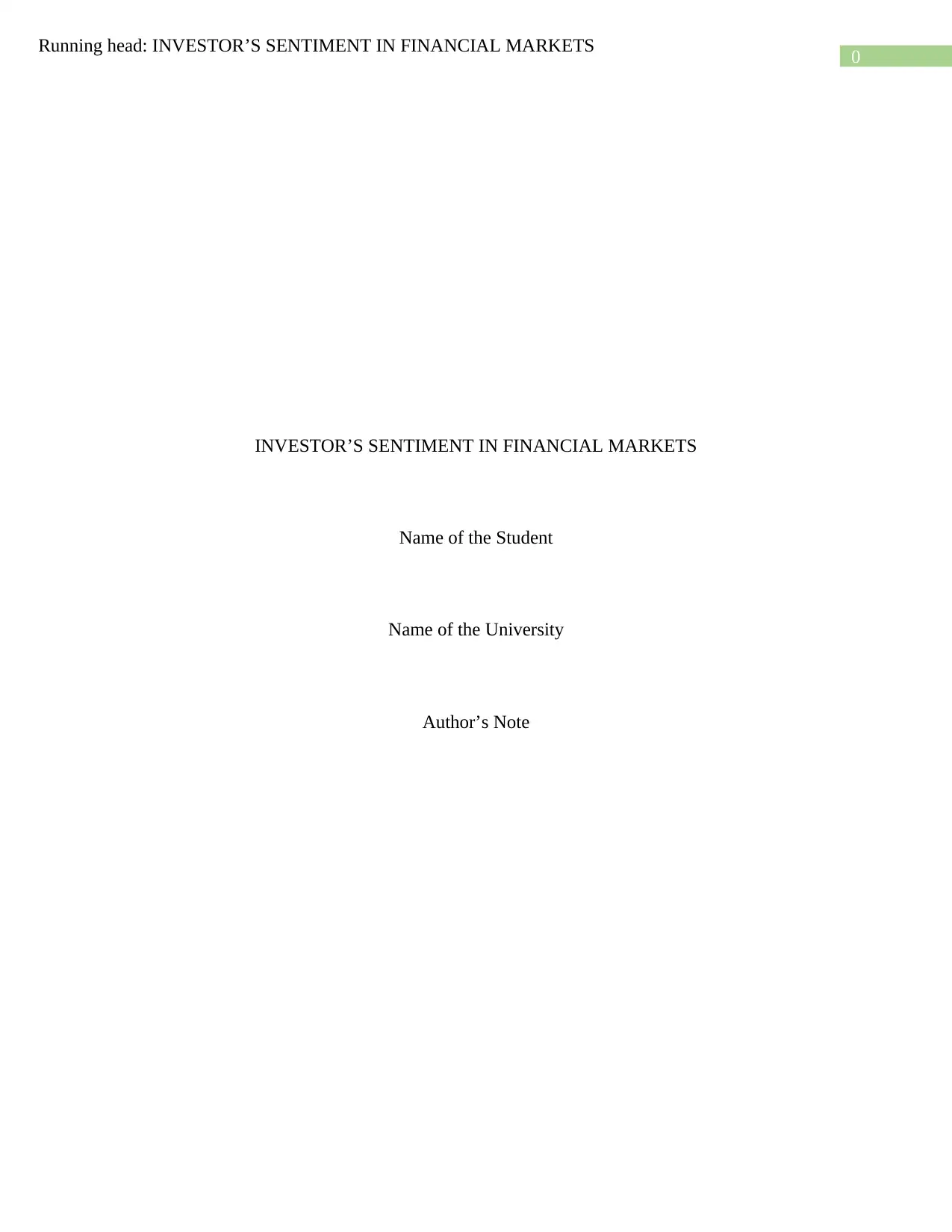
0
Running head: INVESTOR’S SENTIMENT IN FINANCIAL MARKETS
INVESTOR’S SENTIMENT IN FINANCIAL MARKETS
Name of the Student
Name of the University
Author’s Note
Running head: INVESTOR’S SENTIMENT IN FINANCIAL MARKETS
INVESTOR’S SENTIMENT IN FINANCIAL MARKETS
Name of the Student
Name of the University
Author’s Note
Paraphrase This Document
Need a fresh take? Get an instant paraphrase of this document with our AI Paraphraser
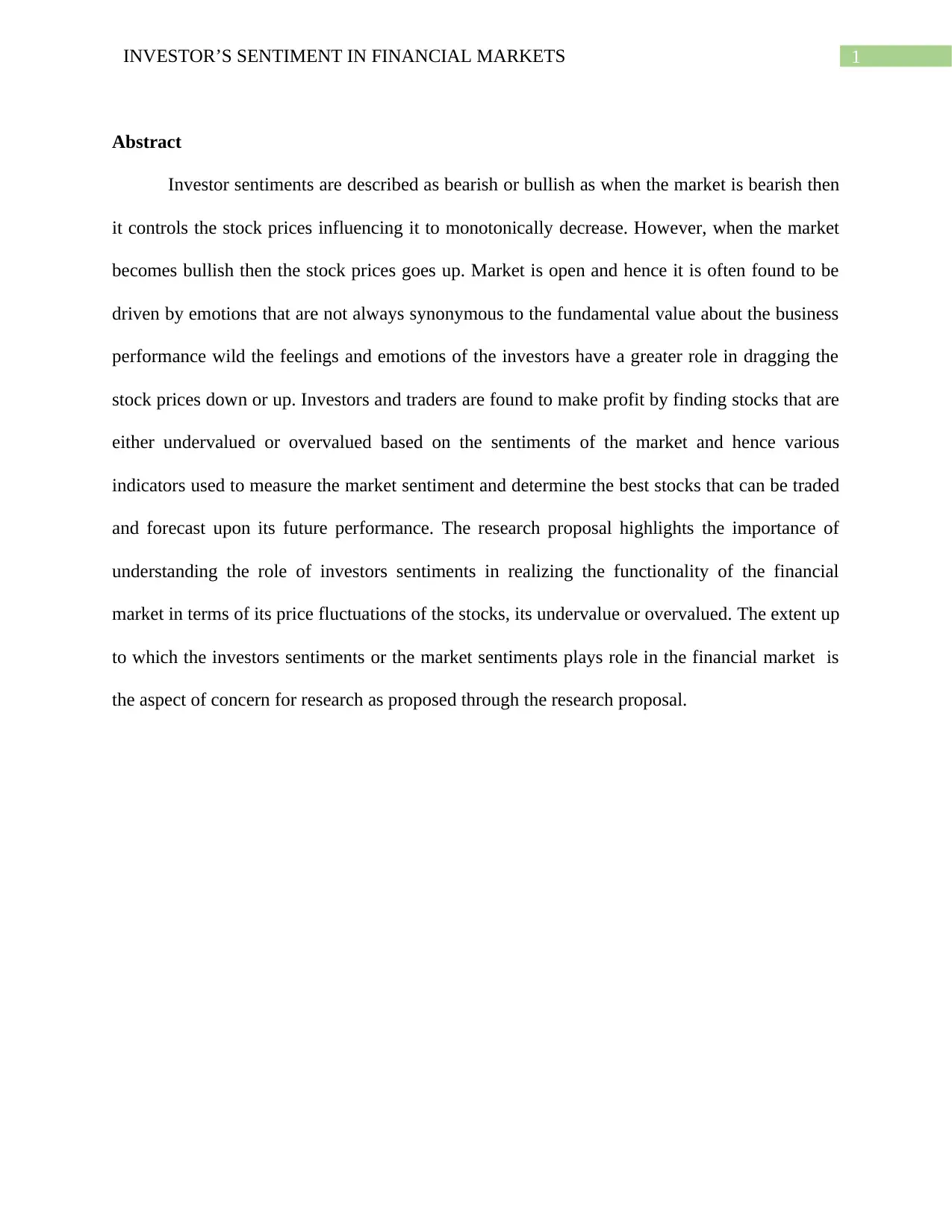
1INVESTOR’S SENTIMENT IN FINANCIAL MARKETS
Abstract
Investor sentiments are described as bearish or bullish as when the market is bearish then
it controls the stock prices influencing it to monotonically decrease. However, when the market
becomes bullish then the stock prices goes up. Market is open and hence it is often found to be
driven by emotions that are not always synonymous to the fundamental value about the business
performance wild the feelings and emotions of the investors have a greater role in dragging the
stock prices down or up. Investors and traders are found to make profit by finding stocks that are
either undervalued or overvalued based on the sentiments of the market and hence various
indicators used to measure the market sentiment and determine the best stocks that can be traded
and forecast upon its future performance. The research proposal highlights the importance of
understanding the role of investors sentiments in realizing the functionality of the financial
market in terms of its price fluctuations of the stocks, its undervalue or overvalued. The extent up
to which the investors sentiments or the market sentiments plays role in the financial market is
the aspect of concern for research as proposed through the research proposal.
Abstract
Investor sentiments are described as bearish or bullish as when the market is bearish then
it controls the stock prices influencing it to monotonically decrease. However, when the market
becomes bullish then the stock prices goes up. Market is open and hence it is often found to be
driven by emotions that are not always synonymous to the fundamental value about the business
performance wild the feelings and emotions of the investors have a greater role in dragging the
stock prices down or up. Investors and traders are found to make profit by finding stocks that are
either undervalued or overvalued based on the sentiments of the market and hence various
indicators used to measure the market sentiment and determine the best stocks that can be traded
and forecast upon its future performance. The research proposal highlights the importance of
understanding the role of investors sentiments in realizing the functionality of the financial
market in terms of its price fluctuations of the stocks, its undervalue or overvalued. The extent up
to which the investors sentiments or the market sentiments plays role in the financial market is
the aspect of concern for research as proposed through the research proposal.
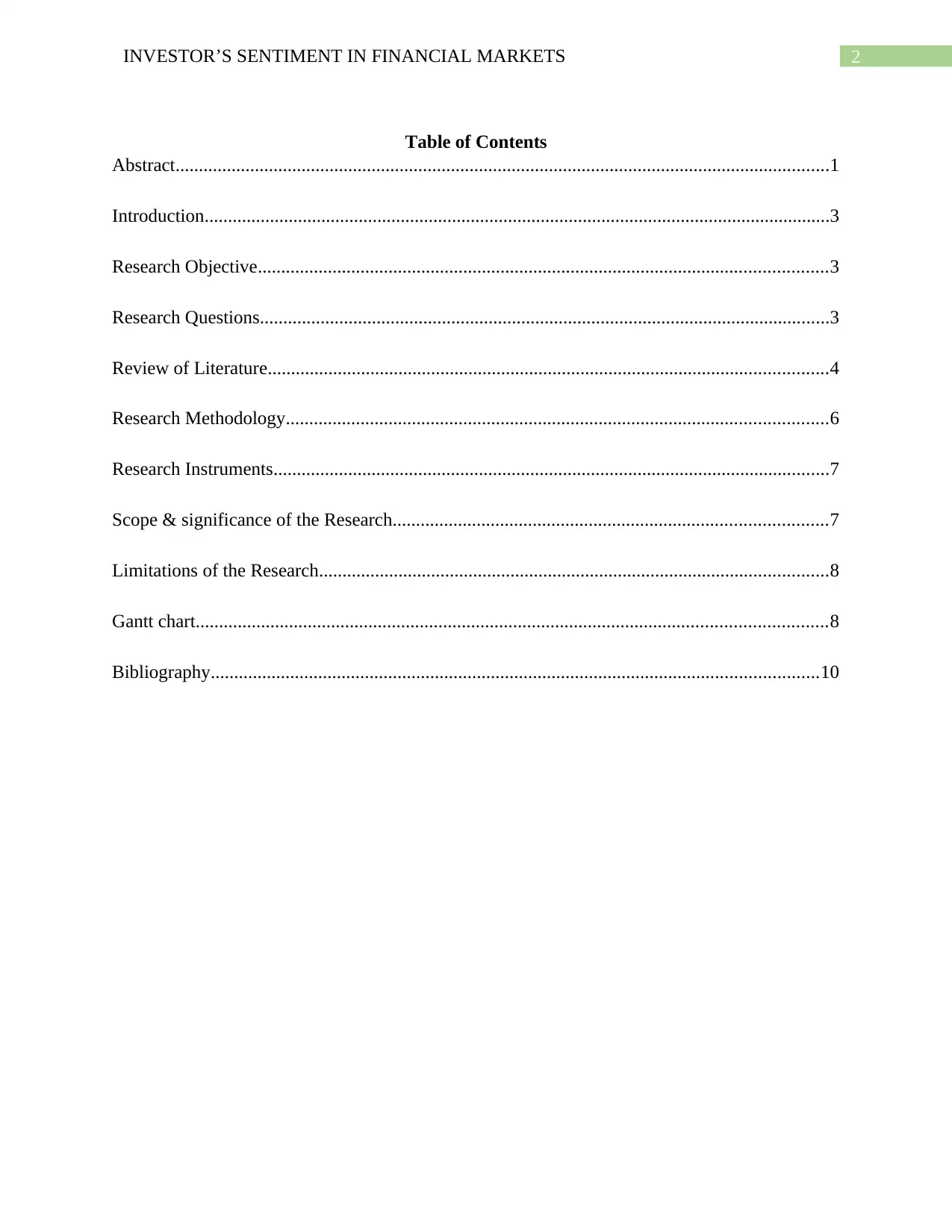
2INVESTOR’S SENTIMENT IN FINANCIAL MARKETS
Table of Contents
Abstract............................................................................................................................................1
Introduction......................................................................................................................................3
Research Objective..........................................................................................................................3
Research Questions..........................................................................................................................3
Review of Literature........................................................................................................................4
Research Methodology....................................................................................................................6
Research Instruments.......................................................................................................................7
Scope & significance of the Research.............................................................................................7
Limitations of the Research.............................................................................................................8
Gantt chart.......................................................................................................................................8
Bibliography..................................................................................................................................10
Table of Contents
Abstract............................................................................................................................................1
Introduction......................................................................................................................................3
Research Objective..........................................................................................................................3
Research Questions..........................................................................................................................3
Review of Literature........................................................................................................................4
Research Methodology....................................................................................................................6
Research Instruments.......................................................................................................................7
Scope & significance of the Research.............................................................................................7
Limitations of the Research.............................................................................................................8
Gantt chart.......................................................................................................................................8
Bibliography..................................................................................................................................10
⊘ This is a preview!⊘
Do you want full access?
Subscribe today to unlock all pages.

Trusted by 1+ million students worldwide
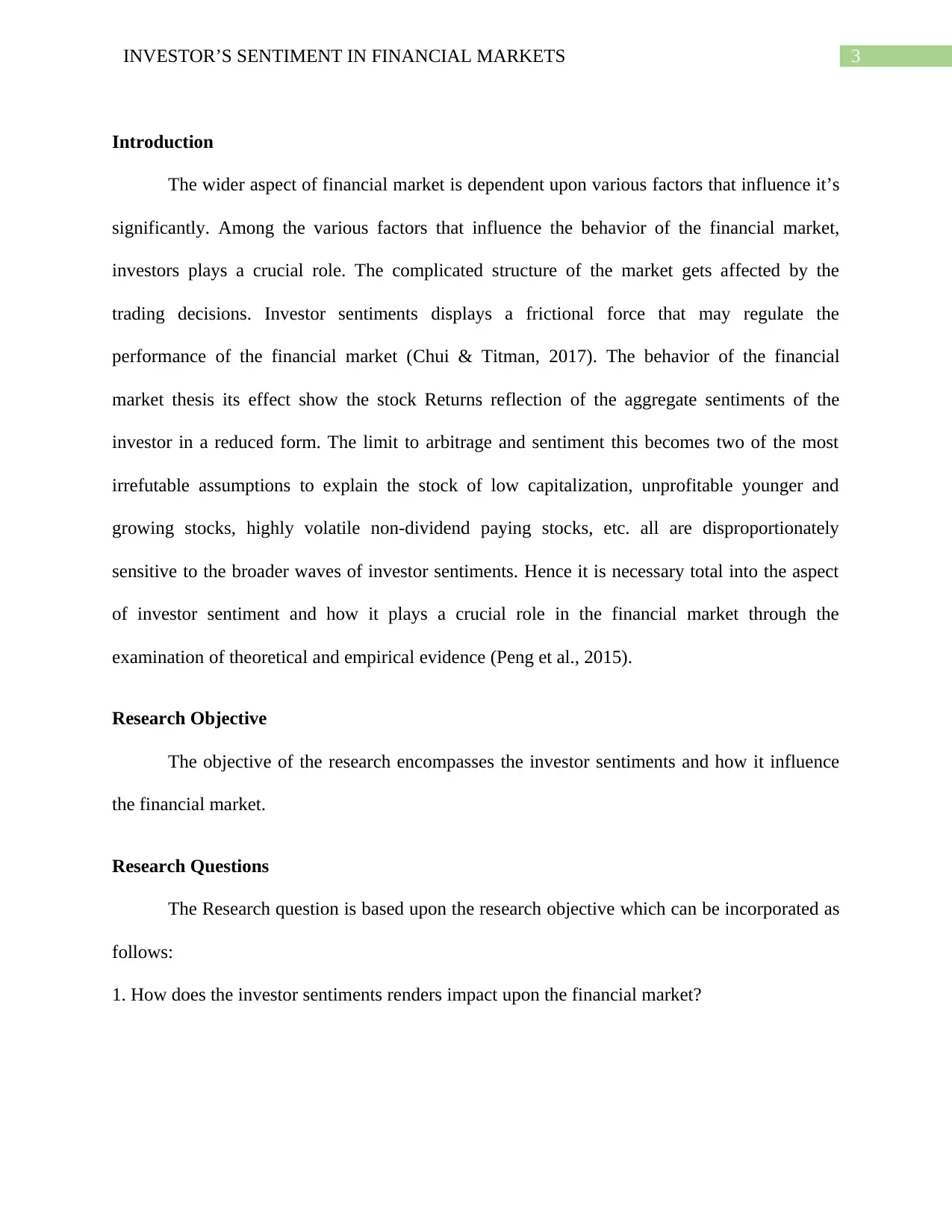
3INVESTOR’S SENTIMENT IN FINANCIAL MARKETS
Introduction
The wider aspect of financial market is dependent upon various factors that influence it’s
significantly. Among the various factors that influence the behavior of the financial market,
investors plays a crucial role. The complicated structure of the market gets affected by the
trading decisions. Investor sentiments displays a frictional force that may regulate the
performance of the financial market (Chui & Titman, 2017). The behavior of the financial
market thesis its effect show the stock Returns reflection of the aggregate sentiments of the
investor in a reduced form. The limit to arbitrage and sentiment this becomes two of the most
irrefutable assumptions to explain the stock of low capitalization, unprofitable younger and
growing stocks, highly volatile non-dividend paying stocks, etc. all are disproportionately
sensitive to the broader waves of investor sentiments. Hence it is necessary total into the aspect
of investor sentiment and how it plays a crucial role in the financial market through the
examination of theoretical and empirical evidence (Peng et al., 2015).
Research Objective
The objective of the research encompasses the investor sentiments and how it influence
the financial market.
Research Questions
The Research question is based upon the research objective which can be incorporated as
follows:
1. How does the investor sentiments renders impact upon the financial market?
Introduction
The wider aspect of financial market is dependent upon various factors that influence it’s
significantly. Among the various factors that influence the behavior of the financial market,
investors plays a crucial role. The complicated structure of the market gets affected by the
trading decisions. Investor sentiments displays a frictional force that may regulate the
performance of the financial market (Chui & Titman, 2017). The behavior of the financial
market thesis its effect show the stock Returns reflection of the aggregate sentiments of the
investor in a reduced form. The limit to arbitrage and sentiment this becomes two of the most
irrefutable assumptions to explain the stock of low capitalization, unprofitable younger and
growing stocks, highly volatile non-dividend paying stocks, etc. all are disproportionately
sensitive to the broader waves of investor sentiments. Hence it is necessary total into the aspect
of investor sentiment and how it plays a crucial role in the financial market through the
examination of theoretical and empirical evidence (Peng et al., 2015).
Research Objective
The objective of the research encompasses the investor sentiments and how it influence
the financial market.
Research Questions
The Research question is based upon the research objective which can be incorporated as
follows:
1. How does the investor sentiments renders impact upon the financial market?
Paraphrase This Document
Need a fresh take? Get an instant paraphrase of this document with our AI Paraphraser
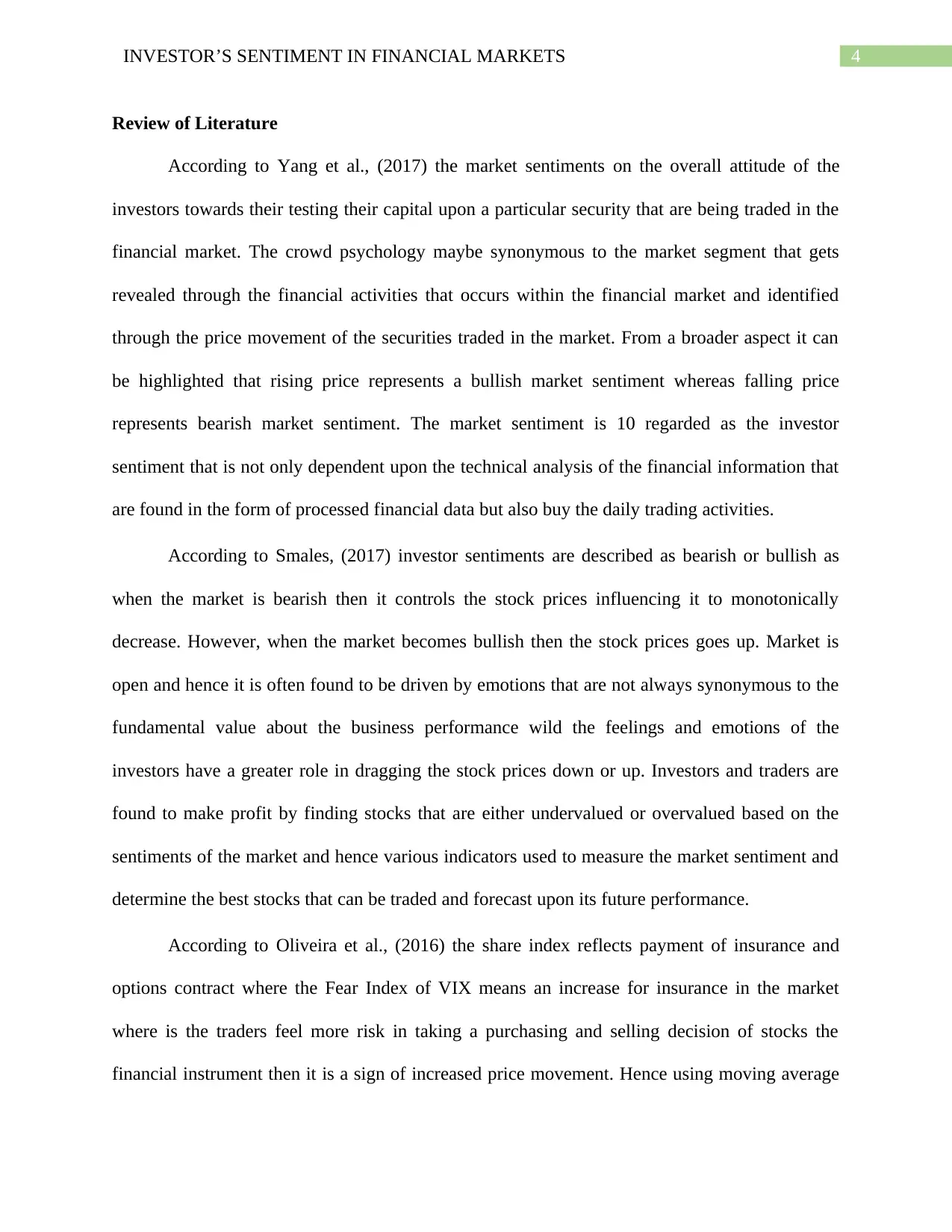
4INVESTOR’S SENTIMENT IN FINANCIAL MARKETS
Review of Literature
According to Yang et al., (2017) the market sentiments on the overall attitude of the
investors towards their testing their capital upon a particular security that are being traded in the
financial market. The crowd psychology maybe synonymous to the market segment that gets
revealed through the financial activities that occurs within the financial market and identified
through the price movement of the securities traded in the market. From a broader aspect it can
be highlighted that rising price represents a bullish market sentiment whereas falling price
represents bearish market sentiment. The market sentiment is 10 regarded as the investor
sentiment that is not only dependent upon the technical analysis of the financial information that
are found in the form of processed financial data but also buy the daily trading activities.
According to Smales, (2017) investor sentiments are described as bearish or bullish as
when the market is bearish then it controls the stock prices influencing it to monotonically
decrease. However, when the market becomes bullish then the stock prices goes up. Market is
open and hence it is often found to be driven by emotions that are not always synonymous to the
fundamental value about the business performance wild the feelings and emotions of the
investors have a greater role in dragging the stock prices down or up. Investors and traders are
found to make profit by finding stocks that are either undervalued or overvalued based on the
sentiments of the market and hence various indicators used to measure the market sentiment and
determine the best stocks that can be traded and forecast upon its future performance.
According to Oliveira et al., (2016) the share index reflects payment of insurance and
options contract where the Fear Index of VIX means an increase for insurance in the market
where is the traders feel more risk in taking a purchasing and selling decision of stocks the
financial instrument then it is a sign of increased price movement. Hence using moving average
Review of Literature
According to Yang et al., (2017) the market sentiments on the overall attitude of the
investors towards their testing their capital upon a particular security that are being traded in the
financial market. The crowd psychology maybe synonymous to the market segment that gets
revealed through the financial activities that occurs within the financial market and identified
through the price movement of the securities traded in the market. From a broader aspect it can
be highlighted that rising price represents a bullish market sentiment whereas falling price
represents bearish market sentiment. The market sentiment is 10 regarded as the investor
sentiment that is not only dependent upon the technical analysis of the financial information that
are found in the form of processed financial data but also buy the daily trading activities.
According to Smales, (2017) investor sentiments are described as bearish or bullish as
when the market is bearish then it controls the stock prices influencing it to monotonically
decrease. However, when the market becomes bullish then the stock prices goes up. Market is
open and hence it is often found to be driven by emotions that are not always synonymous to the
fundamental value about the business performance wild the feelings and emotions of the
investors have a greater role in dragging the stock prices down or up. Investors and traders are
found to make profit by finding stocks that are either undervalued or overvalued based on the
sentiments of the market and hence various indicators used to measure the market sentiment and
determine the best stocks that can be traded and forecast upon its future performance.
According to Oliveira et al., (2016) the share index reflects payment of insurance and
options contract where the Fear Index of VIX means an increase for insurance in the market
where is the traders feel more risk in taking a purchasing and selling decision of stocks the
financial instrument then it is a sign of increased price movement. Hence using moving average
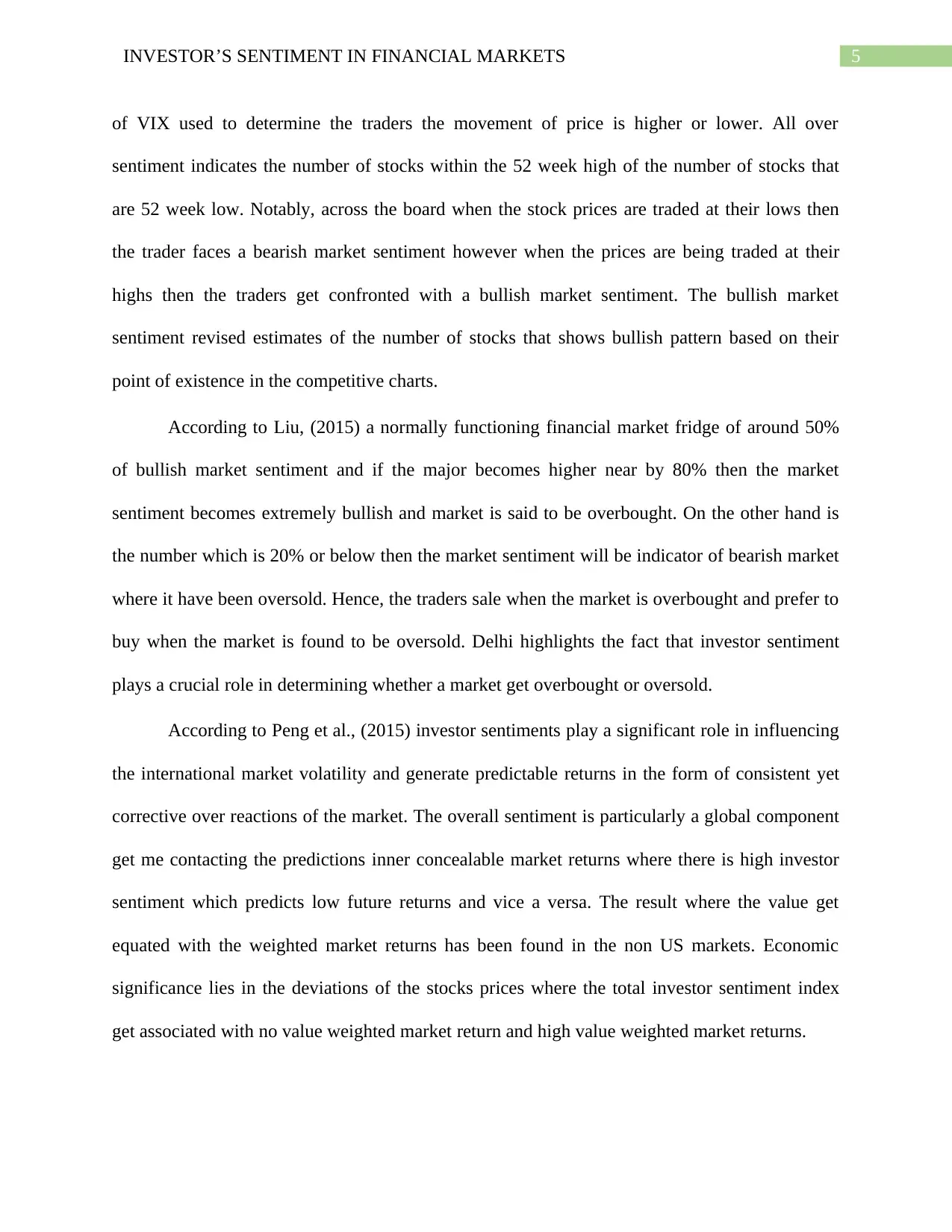
5INVESTOR’S SENTIMENT IN FINANCIAL MARKETS
of VIX used to determine the traders the movement of price is higher or lower. All over
sentiment indicates the number of stocks within the 52 week high of the number of stocks that
are 52 week low. Notably, across the board when the stock prices are traded at their lows then
the trader faces a bearish market sentiment however when the prices are being traded at their
highs then the traders get confronted with a bullish market sentiment. The bullish market
sentiment revised estimates of the number of stocks that shows bullish pattern based on their
point of existence in the competitive charts.
According to Liu, (2015) a normally functioning financial market fridge of around 50%
of bullish market sentiment and if the major becomes higher near by 80% then the market
sentiment becomes extremely bullish and market is said to be overbought. On the other hand is
the number which is 20% or below then the market sentiment will be indicator of bearish market
where it have been oversold. Hence, the traders sale when the market is overbought and prefer to
buy when the market is found to be oversold. Delhi highlights the fact that investor sentiment
plays a crucial role in determining whether a market get overbought or oversold.
According to Peng et al., (2015) investor sentiments play a significant role in influencing
the international market volatility and generate predictable returns in the form of consistent yet
corrective over reactions of the market. The overall sentiment is particularly a global component
get me contacting the predictions inner concealable market returns where there is high investor
sentiment which predicts low future returns and vice a versa. The result where the value get
equated with the weighted market returns has been found in the non US markets. Economic
significance lies in the deviations of the stocks prices where the total investor sentiment index
get associated with no value weighted market return and high value weighted market returns.
of VIX used to determine the traders the movement of price is higher or lower. All over
sentiment indicates the number of stocks within the 52 week high of the number of stocks that
are 52 week low. Notably, across the board when the stock prices are traded at their lows then
the trader faces a bearish market sentiment however when the prices are being traded at their
highs then the traders get confronted with a bullish market sentiment. The bullish market
sentiment revised estimates of the number of stocks that shows bullish pattern based on their
point of existence in the competitive charts.
According to Liu, (2015) a normally functioning financial market fridge of around 50%
of bullish market sentiment and if the major becomes higher near by 80% then the market
sentiment becomes extremely bullish and market is said to be overbought. On the other hand is
the number which is 20% or below then the market sentiment will be indicator of bearish market
where it have been oversold. Hence, the traders sale when the market is overbought and prefer to
buy when the market is found to be oversold. Delhi highlights the fact that investor sentiment
plays a crucial role in determining whether a market get overbought or oversold.
According to Peng et al., (2015) investor sentiments play a significant role in influencing
the international market volatility and generate predictable returns in the form of consistent yet
corrective over reactions of the market. The overall sentiment is particularly a global component
get me contacting the predictions inner concealable market returns where there is high investor
sentiment which predicts low future returns and vice a versa. The result where the value get
equated with the weighted market returns has been found in the non US markets. Economic
significance lies in the deviations of the stocks prices where the total investor sentiment index
get associated with no value weighted market return and high value weighted market returns.
⊘ This is a preview!⊘
Do you want full access?
Subscribe today to unlock all pages.

Trusted by 1+ million students worldwide
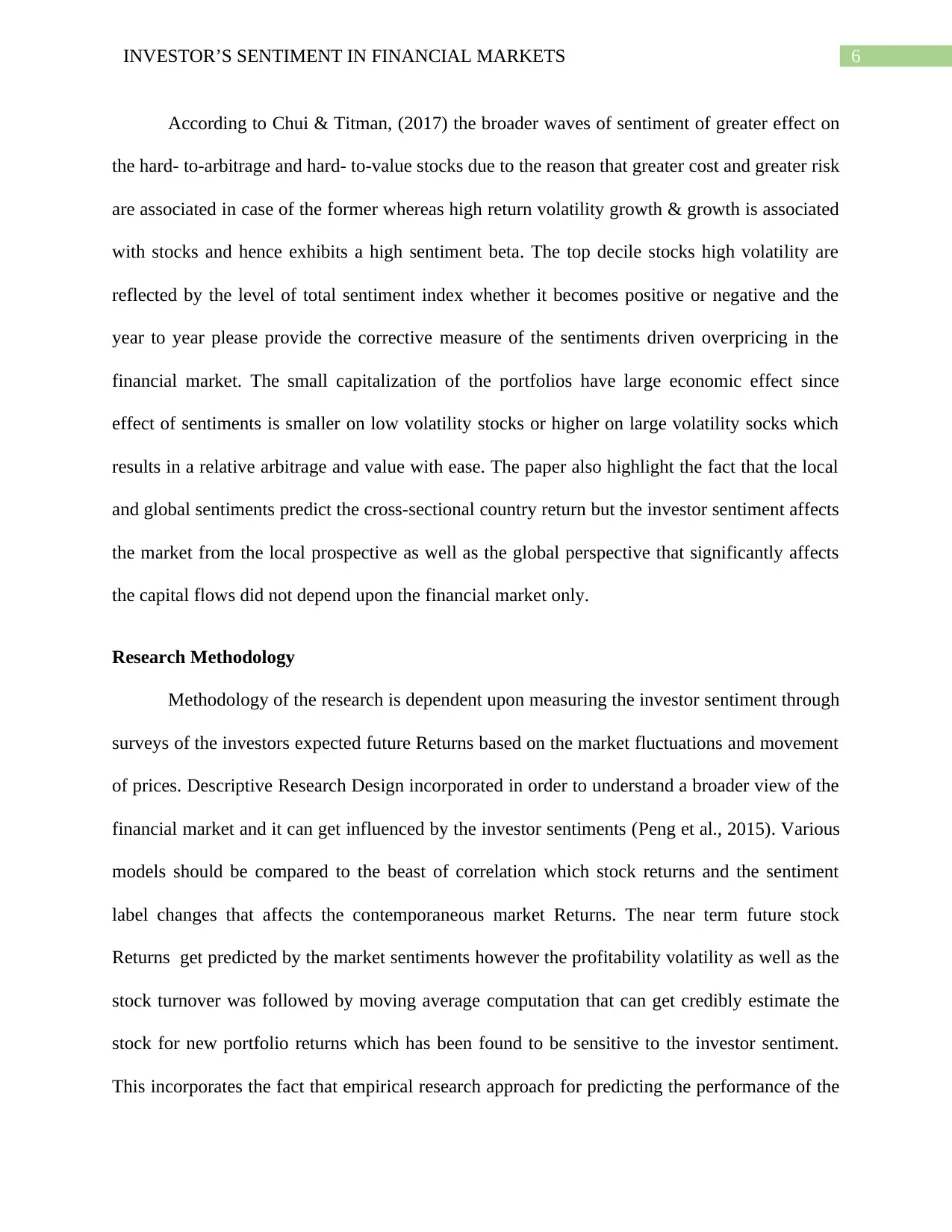
6INVESTOR’S SENTIMENT IN FINANCIAL MARKETS
According to Chui & Titman, (2017) the broader waves of sentiment of greater effect on
the hard- to-arbitrage and hard- to-value stocks due to the reason that greater cost and greater risk
are associated in case of the former whereas high return volatility growth & growth is associated
with stocks and hence exhibits a high sentiment beta. The top decile stocks high volatility are
reflected by the level of total sentiment index whether it becomes positive or negative and the
year to year please provide the corrective measure of the sentiments driven overpricing in the
financial market. The small capitalization of the portfolios have large economic effect since
effect of sentiments is smaller on low volatility stocks or higher on large volatility socks which
results in a relative arbitrage and value with ease. The paper also highlight the fact that the local
and global sentiments predict the cross-sectional country return but the investor sentiment affects
the market from the local prospective as well as the global perspective that significantly affects
the capital flows did not depend upon the financial market only.
Research Methodology
Methodology of the research is dependent upon measuring the investor sentiment through
surveys of the investors expected future Returns based on the market fluctuations and movement
of prices. Descriptive Research Design incorporated in order to understand a broader view of the
financial market and it can get influenced by the investor sentiments (Peng et al., 2015). Various
models should be compared to the beast of correlation which stock returns and the sentiment
label changes that affects the contemporaneous market Returns. The near term future stock
Returns get predicted by the market sentiments however the profitability volatility as well as the
stock turnover was followed by moving average computation that can get credibly estimate the
stock for new portfolio returns which has been found to be sensitive to the investor sentiment.
This incorporates the fact that empirical research approach for predicting the performance of the
According to Chui & Titman, (2017) the broader waves of sentiment of greater effect on
the hard- to-arbitrage and hard- to-value stocks due to the reason that greater cost and greater risk
are associated in case of the former whereas high return volatility growth & growth is associated
with stocks and hence exhibits a high sentiment beta. The top decile stocks high volatility are
reflected by the level of total sentiment index whether it becomes positive or negative and the
year to year please provide the corrective measure of the sentiments driven overpricing in the
financial market. The small capitalization of the portfolios have large economic effect since
effect of sentiments is smaller on low volatility stocks or higher on large volatility socks which
results in a relative arbitrage and value with ease. The paper also highlight the fact that the local
and global sentiments predict the cross-sectional country return but the investor sentiment affects
the market from the local prospective as well as the global perspective that significantly affects
the capital flows did not depend upon the financial market only.
Research Methodology
Methodology of the research is dependent upon measuring the investor sentiment through
surveys of the investors expected future Returns based on the market fluctuations and movement
of prices. Descriptive Research Design incorporated in order to understand a broader view of the
financial market and it can get influenced by the investor sentiments (Peng et al., 2015). Various
models should be compared to the beast of correlation which stock returns and the sentiment
label changes that affects the contemporaneous market Returns. The near term future stock
Returns get predicted by the market sentiments however the profitability volatility as well as the
stock turnover was followed by moving average computation that can get credibly estimate the
stock for new portfolio returns which has been found to be sensitive to the investor sentiment.
This incorporates the fact that empirical research approach for predicting the performance of the
Paraphrase This Document
Need a fresh take? Get an instant paraphrase of this document with our AI Paraphraser
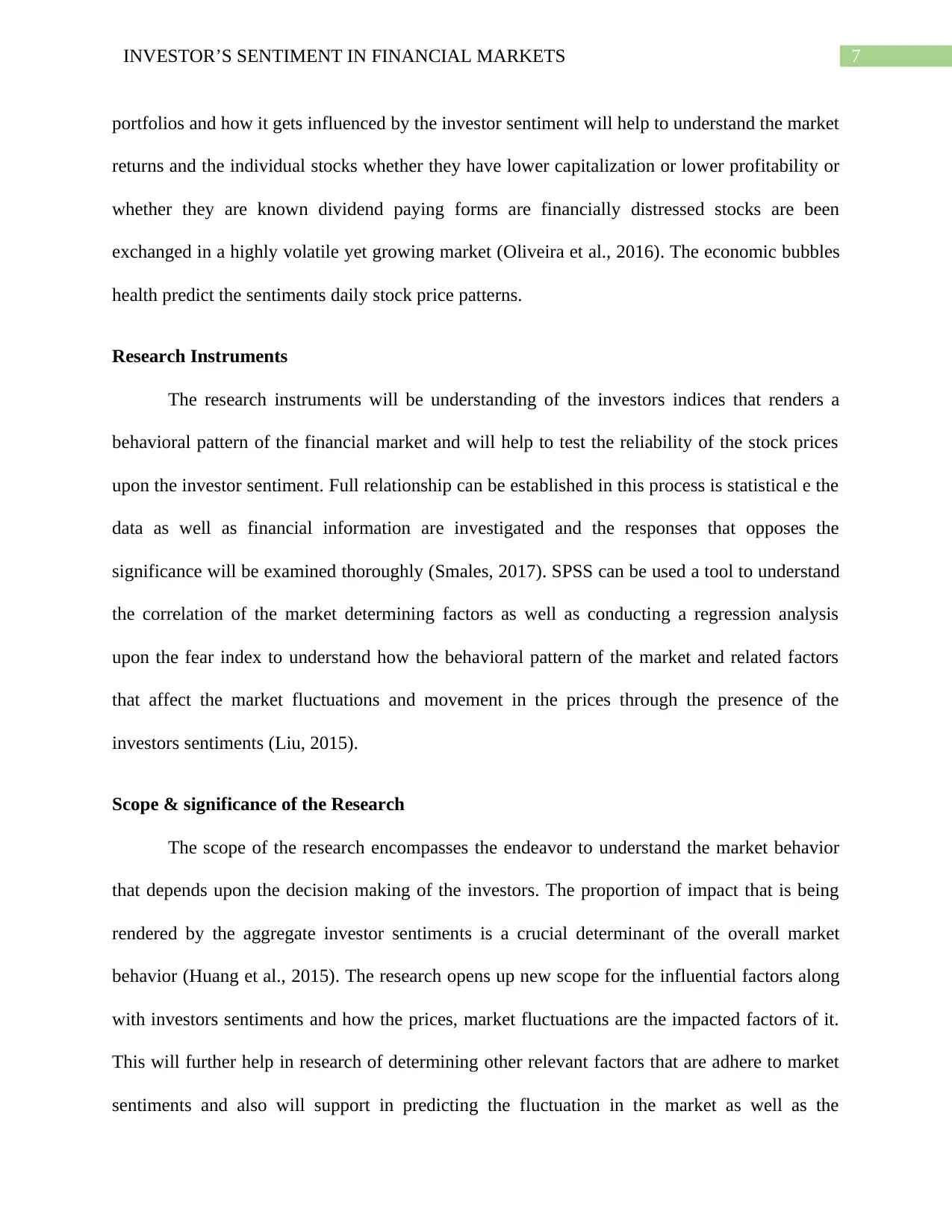
7INVESTOR’S SENTIMENT IN FINANCIAL MARKETS
portfolios and how it gets influenced by the investor sentiment will help to understand the market
returns and the individual stocks whether they have lower capitalization or lower profitability or
whether they are known dividend paying forms are financially distressed stocks are been
exchanged in a highly volatile yet growing market (Oliveira et al., 2016). The economic bubbles
health predict the sentiments daily stock price patterns.
Research Instruments
The research instruments will be understanding of the investors indices that renders a
behavioral pattern of the financial market and will help to test the reliability of the stock prices
upon the investor sentiment. Full relationship can be established in this process is statistical e the
data as well as financial information are investigated and the responses that opposes the
significance will be examined thoroughly (Smales, 2017). SPSS can be used a tool to understand
the correlation of the market determining factors as well as conducting a regression analysis
upon the fear index to understand how the behavioral pattern of the market and related factors
that affect the market fluctuations and movement in the prices through the presence of the
investors sentiments (Liu, 2015).
Scope & significance of the Research
The scope of the research encompasses the endeavor to understand the market behavior
that depends upon the decision making of the investors. The proportion of impact that is being
rendered by the aggregate investor sentiments is a crucial determinant of the overall market
behavior (Huang et al., 2015). The research opens up new scope for the influential factors along
with investors sentiments and how the prices, market fluctuations are the impacted factors of it.
This will further help in research of determining other relevant factors that are adhere to market
sentiments and also will support in predicting the fluctuation in the market as well as the
portfolios and how it gets influenced by the investor sentiment will help to understand the market
returns and the individual stocks whether they have lower capitalization or lower profitability or
whether they are known dividend paying forms are financially distressed stocks are been
exchanged in a highly volatile yet growing market (Oliveira et al., 2016). The economic bubbles
health predict the sentiments daily stock price patterns.
Research Instruments
The research instruments will be understanding of the investors indices that renders a
behavioral pattern of the financial market and will help to test the reliability of the stock prices
upon the investor sentiment. Full relationship can be established in this process is statistical e the
data as well as financial information are investigated and the responses that opposes the
significance will be examined thoroughly (Smales, 2017). SPSS can be used a tool to understand
the correlation of the market determining factors as well as conducting a regression analysis
upon the fear index to understand how the behavioral pattern of the market and related factors
that affect the market fluctuations and movement in the prices through the presence of the
investors sentiments (Liu, 2015).
Scope & significance of the Research
The scope of the research encompasses the endeavor to understand the market behavior
that depends upon the decision making of the investors. The proportion of impact that is being
rendered by the aggregate investor sentiments is a crucial determinant of the overall market
behavior (Huang et al., 2015). The research opens up new scope for the influential factors along
with investors sentiments and how the prices, market fluctuations are the impacted factors of it.
This will further help in research of determining other relevant factors that are adhere to market
sentiments and also will support in predicting the fluctuation in the market as well as the
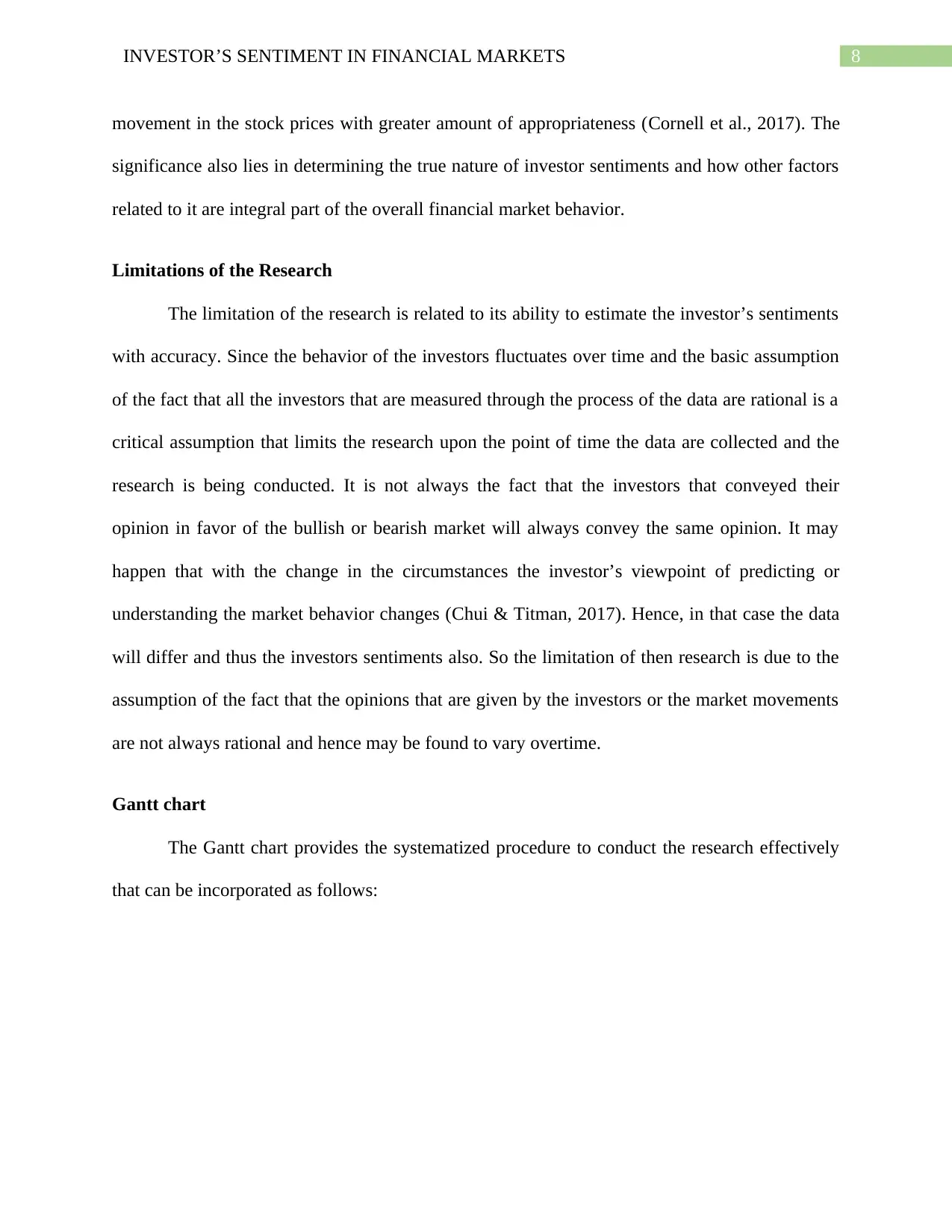
8INVESTOR’S SENTIMENT IN FINANCIAL MARKETS
movement in the stock prices with greater amount of appropriateness (Cornell et al., 2017). The
significance also lies in determining the true nature of investor sentiments and how other factors
related to it are integral part of the overall financial market behavior.
Limitations of the Research
The limitation of the research is related to its ability to estimate the investor’s sentiments
with accuracy. Since the behavior of the investors fluctuates over time and the basic assumption
of the fact that all the investors that are measured through the process of the data are rational is a
critical assumption that limits the research upon the point of time the data are collected and the
research is being conducted. It is not always the fact that the investors that conveyed their
opinion in favor of the bullish or bearish market will always convey the same opinion. It may
happen that with the change in the circumstances the investor’s viewpoint of predicting or
understanding the market behavior changes (Chui & Titman, 2017). Hence, in that case the data
will differ and thus the investors sentiments also. So the limitation of then research is due to the
assumption of the fact that the opinions that are given by the investors or the market movements
are not always rational and hence may be found to vary overtime.
Gantt chart
The Gantt chart provides the systematized procedure to conduct the research effectively
that can be incorporated as follows:
movement in the stock prices with greater amount of appropriateness (Cornell et al., 2017). The
significance also lies in determining the true nature of investor sentiments and how other factors
related to it are integral part of the overall financial market behavior.
Limitations of the Research
The limitation of the research is related to its ability to estimate the investor’s sentiments
with accuracy. Since the behavior of the investors fluctuates over time and the basic assumption
of the fact that all the investors that are measured through the process of the data are rational is a
critical assumption that limits the research upon the point of time the data are collected and the
research is being conducted. It is not always the fact that the investors that conveyed their
opinion in favor of the bullish or bearish market will always convey the same opinion. It may
happen that with the change in the circumstances the investor’s viewpoint of predicting or
understanding the market behavior changes (Chui & Titman, 2017). Hence, in that case the data
will differ and thus the investors sentiments also. So the limitation of then research is due to the
assumption of the fact that the opinions that are given by the investors or the market movements
are not always rational and hence may be found to vary overtime.
Gantt chart
The Gantt chart provides the systematized procedure to conduct the research effectively
that can be incorporated as follows:
⊘ This is a preview!⊘
Do you want full access?
Subscribe today to unlock all pages.

Trusted by 1+ million students worldwide
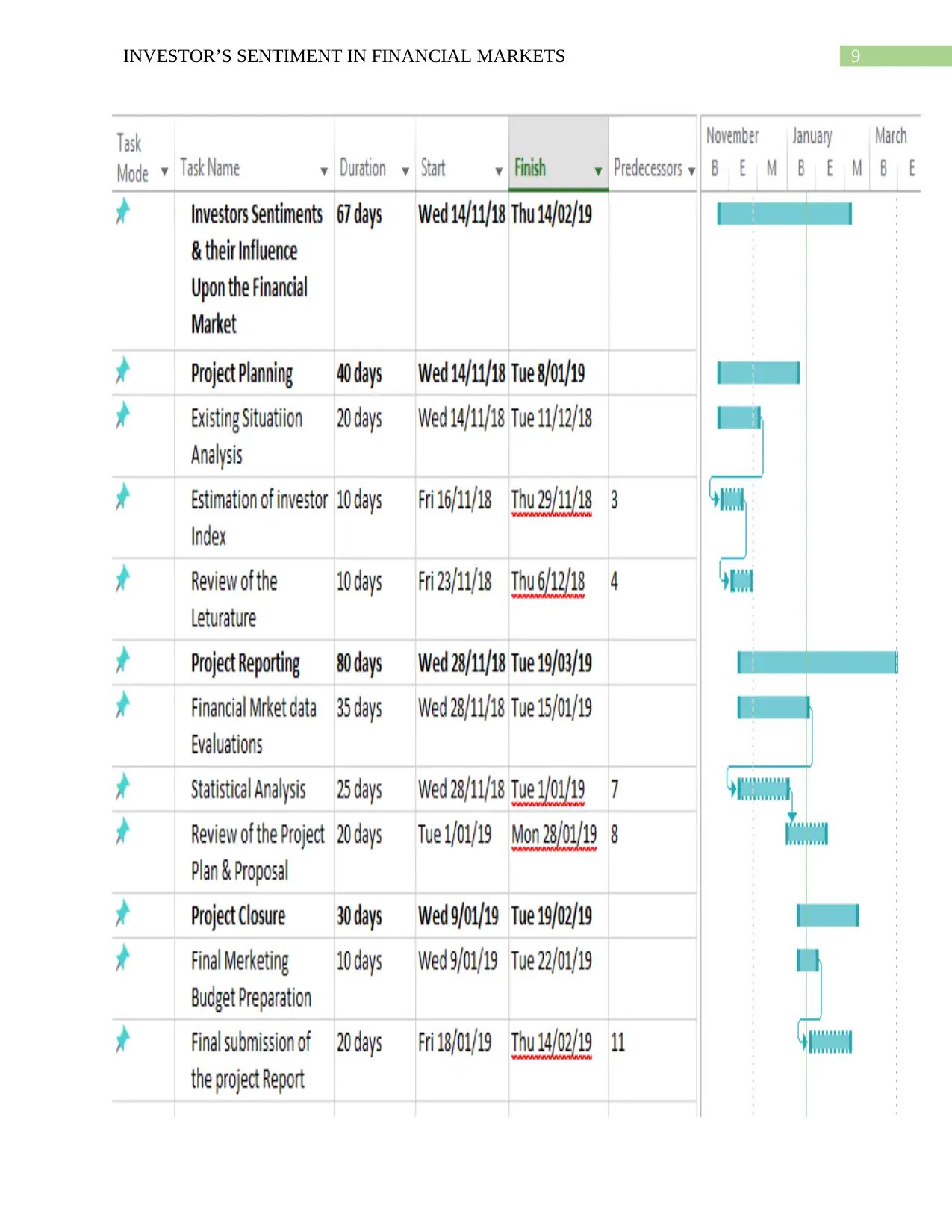
9INVESTOR’S SENTIMENT IN FINANCIAL MARKETS
Paraphrase This Document
Need a fresh take? Get an instant paraphrase of this document with our AI Paraphraser
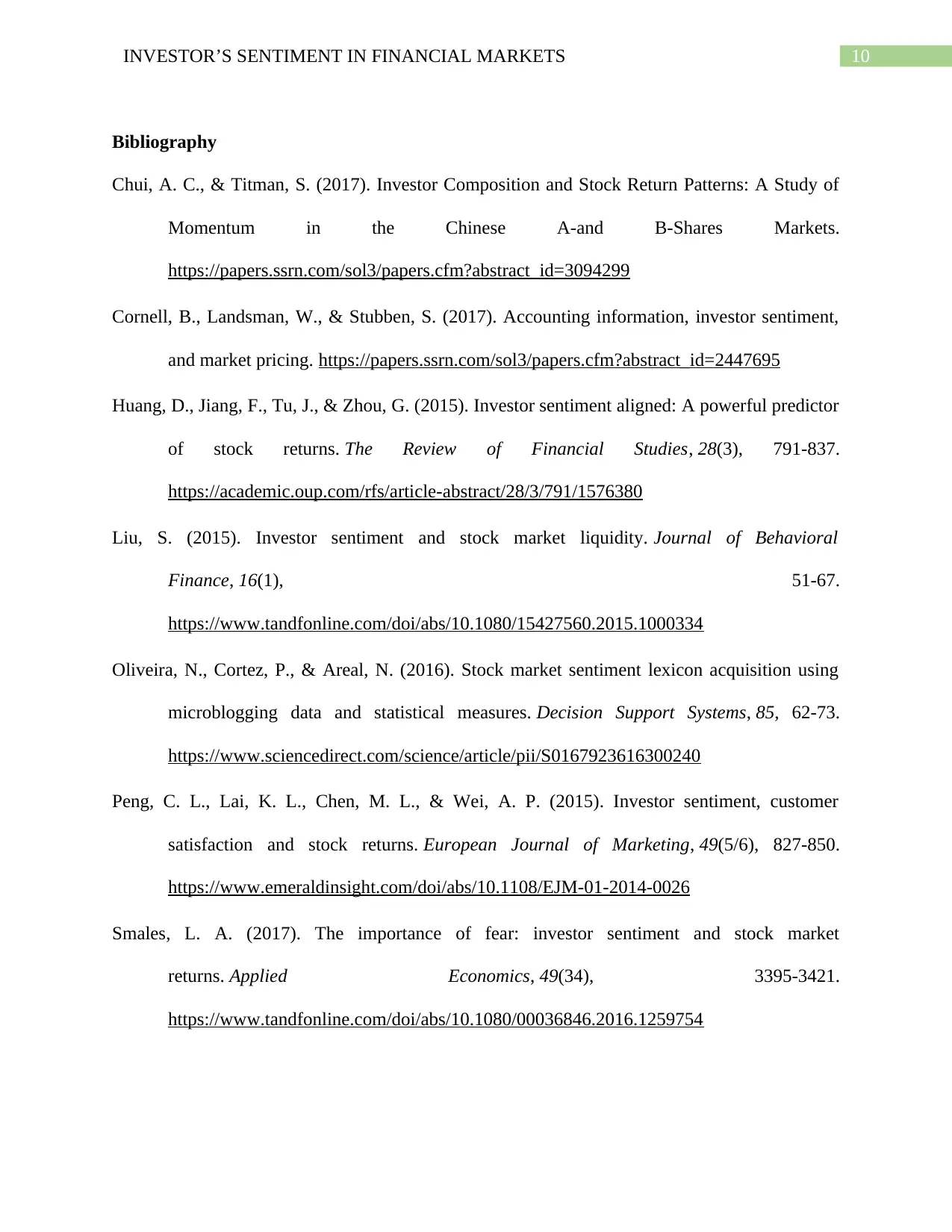
10INVESTOR’S SENTIMENT IN FINANCIAL MARKETS
Bibliography
Chui, A. C., & Titman, S. (2017). Investor Composition and Stock Return Patterns: A Study of
Momentum in the Chinese A-and B-Shares Markets.
https://papers.ssrn.com/sol3/papers.cfm?abstract_id=3094299
Cornell, B., Landsman, W., & Stubben, S. (2017). Accounting information, investor sentiment,
and market pricing. https://papers.ssrn.com/sol3/papers.cfm?abstract_id=2447695
Huang, D., Jiang, F., Tu, J., & Zhou, G. (2015). Investor sentiment aligned: A powerful predictor
of stock returns. The Review of Financial Studies, 28(3), 791-837.
https://academic.oup.com/rfs/article-abstract/28/3/791/1576380
Liu, S. (2015). Investor sentiment and stock market liquidity. Journal of Behavioral
Finance, 16(1), 51-67.
https://www.tandfonline.com/doi/abs/10.1080/15427560.2015.1000334
Oliveira, N., Cortez, P., & Areal, N. (2016). Stock market sentiment lexicon acquisition using
microblogging data and statistical measures. Decision Support Systems, 85, 62-73.
https://www.sciencedirect.com/science/article/pii/S0167923616300240
Peng, C. L., Lai, K. L., Chen, M. L., & Wei, A. P. (2015). Investor sentiment, customer
satisfaction and stock returns. European Journal of Marketing, 49(5/6), 827-850.
https://www.emeraldinsight.com/doi/abs/10.1108/EJM-01-2014-0026
Smales, L. A. (2017). The importance of fear: investor sentiment and stock market
returns. Applied Economics, 49(34), 3395-3421.
https://www.tandfonline.com/doi/abs/10.1080/00036846.2016.1259754
Bibliography
Chui, A. C., & Titman, S. (2017). Investor Composition and Stock Return Patterns: A Study of
Momentum in the Chinese A-and B-Shares Markets.
https://papers.ssrn.com/sol3/papers.cfm?abstract_id=3094299
Cornell, B., Landsman, W., & Stubben, S. (2017). Accounting information, investor sentiment,
and market pricing. https://papers.ssrn.com/sol3/papers.cfm?abstract_id=2447695
Huang, D., Jiang, F., Tu, J., & Zhou, G. (2015). Investor sentiment aligned: A powerful predictor
of stock returns. The Review of Financial Studies, 28(3), 791-837.
https://academic.oup.com/rfs/article-abstract/28/3/791/1576380
Liu, S. (2015). Investor sentiment and stock market liquidity. Journal of Behavioral
Finance, 16(1), 51-67.
https://www.tandfonline.com/doi/abs/10.1080/15427560.2015.1000334
Oliveira, N., Cortez, P., & Areal, N. (2016). Stock market sentiment lexicon acquisition using
microblogging data and statistical measures. Decision Support Systems, 85, 62-73.
https://www.sciencedirect.com/science/article/pii/S0167923616300240
Peng, C. L., Lai, K. L., Chen, M. L., & Wei, A. P. (2015). Investor sentiment, customer
satisfaction and stock returns. European Journal of Marketing, 49(5/6), 827-850.
https://www.emeraldinsight.com/doi/abs/10.1108/EJM-01-2014-0026
Smales, L. A. (2017). The importance of fear: investor sentiment and stock market
returns. Applied Economics, 49(34), 3395-3421.
https://www.tandfonline.com/doi/abs/10.1080/00036846.2016.1259754
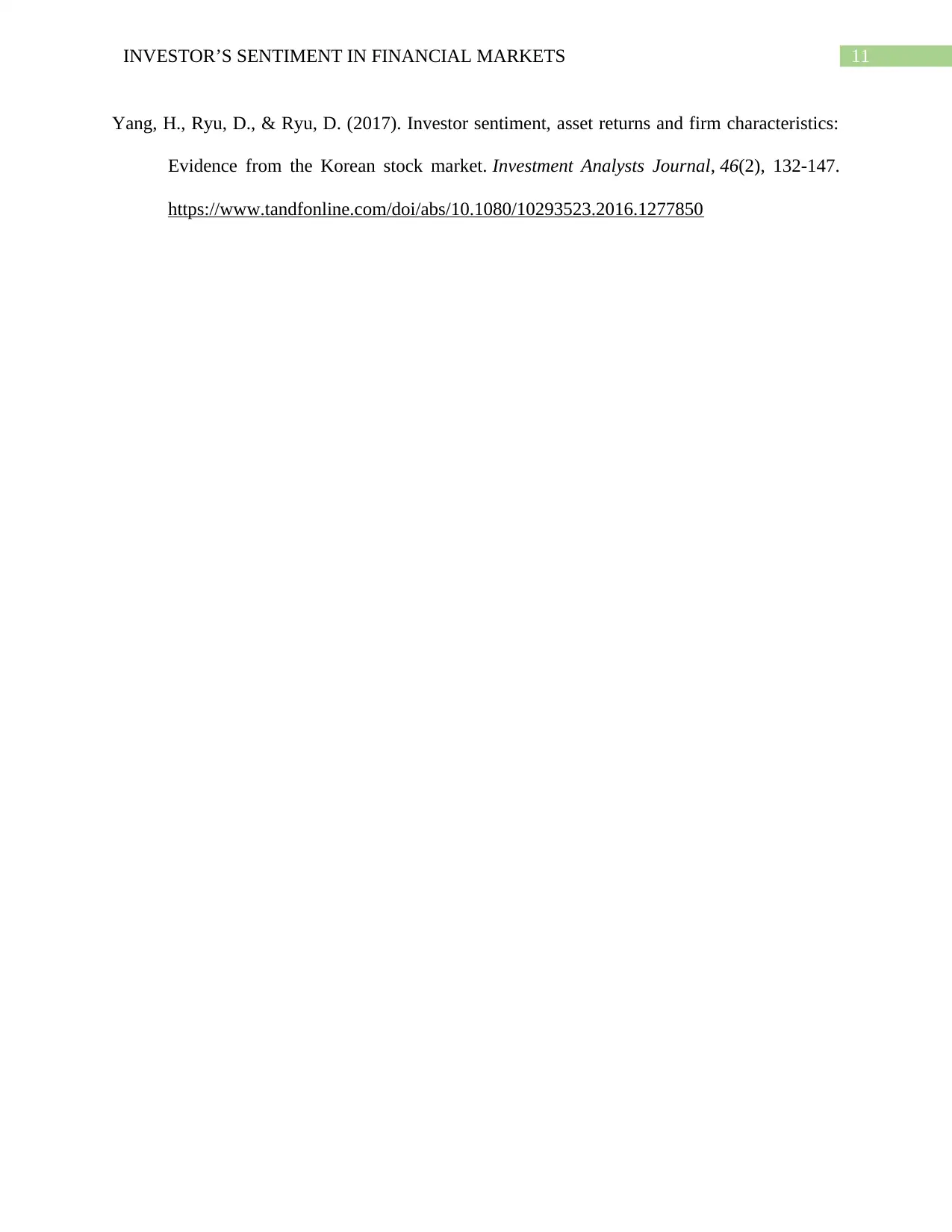
11INVESTOR’S SENTIMENT IN FINANCIAL MARKETS
Yang, H., Ryu, D., & Ryu, D. (2017). Investor sentiment, asset returns and firm characteristics:
Evidence from the Korean stock market. Investment Analysts Journal, 46(2), 132-147.
https://www.tandfonline.com/doi/abs/10.1080/10293523.2016.1277850
Yang, H., Ryu, D., & Ryu, D. (2017). Investor sentiment, asset returns and firm characteristics:
Evidence from the Korean stock market. Investment Analysts Journal, 46(2), 132-147.
https://www.tandfonline.com/doi/abs/10.1080/10293523.2016.1277850
⊘ This is a preview!⊘
Do you want full access?
Subscribe today to unlock all pages.

Trusted by 1+ million students worldwide
1 out of 12
Related Documents
Your All-in-One AI-Powered Toolkit for Academic Success.
+13062052269
info@desklib.com
Available 24*7 on WhatsApp / Email
![[object Object]](/_next/static/media/star-bottom.7253800d.svg)
Unlock your academic potential
Copyright © 2020–2025 A2Z Services. All Rights Reserved. Developed and managed by ZUCOL.





